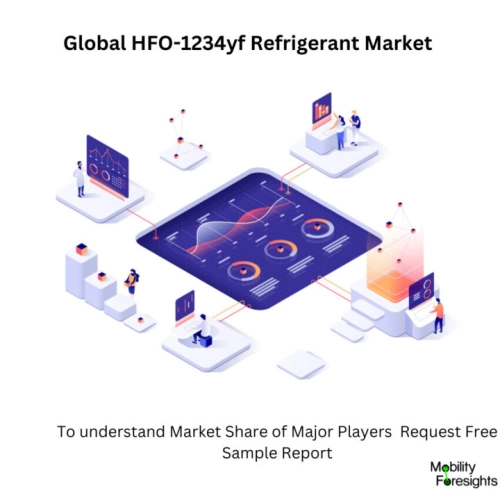
- Get in Touch with Us

Last Updated: Apr 25, 2025 | Study Period: 2023-2030
The hydrofluoroolefins class of novel refrigerants includes HFO-1234yf. These refrigerants are comparable to HFC refrigerants, with the exception that they have a substantially lower GPP. By forming a double carbon bond within HFO refrigerants, this is accomplished.
If the refrigerant leaks or is vented, this double bond can be easily broken down in the environment. The first of these classes of refrigerants, 1234yf, will take the place of R-134a in automotive applications.
It has been created to use hydrofluoro-olefin 2,3,3,3-tetrafluoropropene (HFO-1234yf). With a GWP of 4, HFO-1234yf has an extremely brief atmospheric lifespan of only 0.03 years.
This work includes measurements of HFO-1234yf's critical temperature, vapour pressure, liquid density, ideal gas heat capacity, liquid viscosity, and surface tension.
Utilizing the experimental data, a corresponding state equation of state has been regressed. These data enable the performance evaluation of HFO-1234yf in current air conditioning applications as well as the design of future refrigeration systems.
The capacity and efficiency previously observed in applications like mobile air conditioning have been demonstrated to be maintained by HFO-1234yf.

Global hfo-1234yf refrigerant market accounted for $XX Billion in 2022 and is anticipated to reach $XX Billion by 2030, registering a CAGR of XX% from 2023 to 2030.
A new line of large-capacity centrifugal chillers will be introduced by Mitsubishi Heavy Industries Thermal Systems, Ltd., a division of Mitsubishi Heavy Industries, Ltd. (MHI), using the CFC-free(Note1) HFO-1234yf refrigerant, which has zero ozone depletion and a GWP(Note2) below 1.
The constant-speed JHT-Y and the inverter-equipped JHT-YI are the two models in the series.
The maximum capacity of the two new models is 5,400 refrigeration tonnes (RT)(Note 3), which is a 400 RT increase over the "GART-ZE/ZEI" series introduced in 2017.
The JHT-Y and JHT-YI are the first commercially available centrifugal chillers in Japan with capacities up to 5,400 RT that use a low-GWP refrigerant. In addition to the small-to-medium capacity "ETI-Z" series centrifugal chillers introduced in 2015,Additionally, a brand-new type of compressor is used in the new series.
Expanding the number of models makes it possible to choose the best compressor to match the chiller's output and achieve great performance over a wide capacity range.
The constant-speed variant, which continues to offer one of the best levels of energy efficiency and compact dimensions, has a rating COP(Note4) of 6.9.
The newest microcomputer operating panel allows for the supremely precise control of the new series of chillers, and both the constant-speed and inverter models may adapt to a variety of applications, including low-temperature, heat-pump, and heat-recovery requirements.
| Sl no | Topic |
| 1 | Market Segmentation |
| 2 | Scope of the report |
| 3 | Abbreviations |
| 4 | Research Methodology |
| 5 | Executive Summary |
| 6 | Introduction |
| 7 | Insights from Industry stakeholders |
| 8 | Cost breakdown of Product by sub-components and average profit margin |
| 9 | Disruptive innovation in the Industry |
| 10 | Technology trends in the Industry |
| 11 | Consumer trends in the industry |
| 12 | Recent Production Milestones |
| 13 | Component Manufacturing in US, EU and China |
| 14 | COVID-19 impact on overall market |
| 15 | COVID-19 impact on Production of components |
| 16 | COVID-19 impact on Point of sale |
| 17 | Market Segmentation, Dynamics and Forecast by Geography, 2023-2030 |
| 18 | Market Segmentation, Dynamics and Forecast by Product Type, 2023-2030 |
| 19 | Market Segmentation, Dynamics and Forecast by Application, 2023-2030 |
| 20 | Market Segmentation, Dynamics and Forecast by End use, 2023-2030 |
| 21 | Product installation rate by OEM, 2023 |
| 22 | Incline/Decline in Average B-2-B selling price in past 5 years |
| 23 | Competition from substitute products |
| 24 | Gross margin and average profitability of suppliers |
| 25 | New product development in past 12 months |
| 26 | M&A in past 12 months |
| 27 | Growth strategy of leading players |
| 28 | Market share of vendors, 2023 |
| 29 | Company Profiles |
| 30 | Unmet needs and opportunity for new suppliers |
| 31 | Conclusion |
| 32 | Appendix |